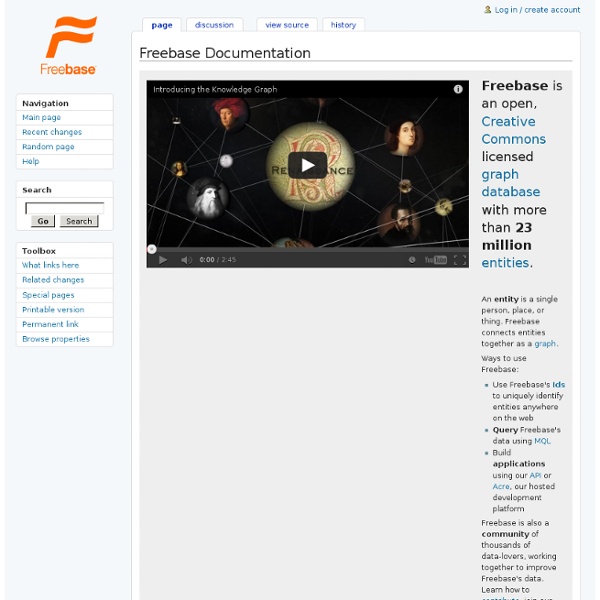



Data Dumps - Freebase API Data Dumps are a downloadable version of the data in Freebase. They constitute a snapshot of the data stored in Freebase and the Schema that structures it, and are provided under the same CC-BY license. The Freebase/Wikidata mappings are provided under the CC0 license. Freebase Triples The RDF data is serialized using the N-Triples format, encoded as UTF-8 text and compressed with Gzip. < "2001-02"^^< . If you're writing your own code to parse the RDF dumps its often more efficient to read directly from GZip file rather than extracting the data first and then processing the uncompressed data. <subject><predicate><object> . Note: In Freebase, objects have MIDs that look like /m/012rkqx. The subject is the ID of a Freebase object. Topic descriptions often contain newlines. Freebase Deleted Triples The columns in the dataset are defined as: License
Basic Concepts - Freebase API If you are new to Freebase, this section covers the basic terminology and concepts required to understand how Freebase works. Graphs Topics Freebase has over 39 million topics about real-world entities like people, places and things. Examples of the types of topics found in Freebase: Physical entities, e.g., Bob Dylan, the Louvre Museum, the Saturn planet, to Artistic/media creations, e.g., The Dark Knight (film), Hotel California (song), to Classifications, e.g., noble gas, Chordate, to Abstract concepts, e.g., love, to Schools of thoughts or artistic movements, e.g., Impressionism. Some topics are notable because they hold a lot of data (e.g., Wal-Mart), and some are notable because they link to many other topics, potentially in different domains of information. Types and Properties Any given topic can be seen for many different perspectives for example: In order to capture this multi-faceted nature of many topics, we introduce the concept of types in Freebase. Domains and IDs Topic MIDs
Introducing the Knowledge Graph: things, not strings Cross-posted on the Inside Search Blog Search is a lot about discovery—the basic human need to learn and broaden your horizons. But searching still requires a lot of hard work by you, the user. So today I’m really excited to launch the Knowledge Graph, which will help you discover new information quickly and easily. Take a query like [taj mahal]. But we all know that [taj mahal] has a much richer meaning. The Knowledge Graph enables you to search for things, people or places that Google knows about—landmarks, celebrities, cities, sports teams, buildings, geographical features, movies, celestial objects, works of art and more—and instantly get information that’s relevant to your query. Google’s Knowledge Graph isn’t just rooted in public sources such as Freebase, Wikipedia and the CIA World Factbook. The Knowledge Graph enhances Google Search in three main ways to start: 1. 2. How do we know which facts are most likely to be needed for each item? 3.
Freebase Freebase is a large collaborative knowledge base consisting of metadata composed mainly by its community members. It is an online collection of structured data harvested from many sources, including individual 'wiki' contributions.[2] Freebase aims to create a global resource which allows people (and machines) to access common information more effectively. It was developed by the American software company Metaweb and has been running publicly since March 2007. Freebase data is freely available for commercial and non-commercial use under a Creative Commons Attribution License, and an open API, RDF endpoint, and database dump are provided for programmers. Overview[edit] On March 3, 2007, Metaweb publicly announced Freebase, described by the company as "an open shared database of the world's knowledge," and "a massive, collaboratively edited database of cross-linked data." Development[edit] Organization and policy[edit] In this manner, Freebase differs from the wiki model in many ways.